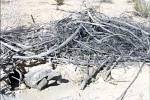Trophy fixation spoils thrill of hunting
Change, it’s been said, is a lot like taxes. It’s a fact of life that we must live with. Change can be brought about through vigorous and open public dialogue, but sometimes change is so subtle that the only way to recognize it is to look at the past. Perhaps that is also the only way to determine whether change is good.
During the past few weeks, I’ve looked back at the world of outdoor writing and can see much about it has changed since I began turning the pages of outdoor magazines as a teenager looking for adventure. Some of those changes are for the better and reflect changes in world politics — changes that have opened parts of the world to hunting and fishing that weren’t available to Americans as few as 20 years ago.
But some of those changes aren’t so good.
Though I wouldn’t go so far as to say my little research project is scientific, it has been enlightening.
It started by accident with a trip to a local bookstore, where I picked up “The Best of Field & Stream, 100 Years of Great Writing.” The book is a collection of articles written by the likes of Zane Grey, Robert Ruark and Norman Strung — all masters of the craft of outdoor writing.
While reading these articles from past eras, some written nearly 100 years ago, I have been transported in time and space. In my mind, I have seen huge flights of geese coming toward decoys positioned along the banks of the Mississippi River and felt the fear of a hunter facing down an angry mountain lion with only a knife in hand.
I have experienced the frustration of a caribou hunter who blew his opportunity to bag a bull by getting so close to the migrating herd that he almost was trampled to death as hundreds of animals rumbled through his hiding place. And I have felt the sting of a cold north wind while waiting for the sun to rise during a hunt in late autumn.
The adventure documented in articles such as those collected in my book encouraged me to pursue my outdoor interests. And I’m guessing many of you — especially those older than 40 — experienced similar enlightenment.
But somewhere along the line, perhaps as new generations of outdoor writers came to be, a subtle change began to take place. Stories focusing on the adventure found in the outdoors began to take a back seat to those focusing on Boone & Crockett or Pope & Young scores, and the focus of many fans of the outdoors followed suit.
Many publications today won’t consider publishing an article that doesn’t include in its text the successful harvest of an animal that earned a qualifying score for some record book or another.
To understand how far this change reaches, consider the stories you and your hunting buddies have swapped while sitting around a campfire in recent years or the articles that appear in the outdoor publications that adorn your coffee table. My guess is the subject of the stories centers on how big a harvested animal was and not on the adventure of the hunt.
Several years ago, I was teaching a hunter education class in Round Mountain, north of Tonopah. At one point, a boy no older than 11 or 12 years raised his hand. When called upon, he made the following statement: “When I go hunting, I’m not going to shoot anything less than a four-point buck with a 28-inch spread.”
A pretty bold statement even for the most experienced hunter, let alone a kid who had yet to carry a deer tag and rifle into a field. Sure, that was youth speaking, but he didn’t develop that philosophy on his own.
Had that young man been born a generation before, perhaps his comment would have been: “I can’t wait to go hunting with my family and get my very first deer!” He probably wouldn’t have been pressured to harvest a deer that meets some predetermined standard of quality in order to qualify as a deer hunter.
Each of us has his or her motivations for hunting, fishing, mountain climbing or participating in other outdoor activities, and that’s OK. But I can’t help but think the outdoor industry’s increased focus on trophy quality rather than the hunting experience itself is pushing hunters and their families out of hunting.
If that’s the case, then I firmly believe the future of hunting could be in jeopardy and the change that came to outdoor literature was not a good thing.
Doug Nielsen is an award-winning freelance writer and a conservation educator for the Nevada Department of Wildlife. He can be reached at doug@takinitoutside.com.
C. DOUGLAS NIELSENMORECOLUMNS


















